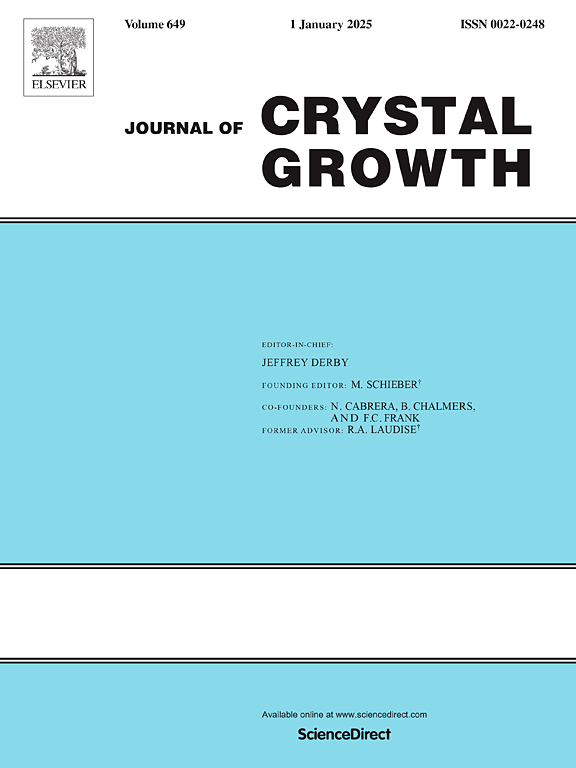利用原藜叶提取物绿色合成α-MoO3纳米棒,用于光降解和抗菌阳离子三色素
IF 1.7
4区 材料科学
Q3 CRYSTALLOGRAPHY
引用次数: 0
摘要
本研究以原藜叶提取物为天然还原稳定剂,在分散介质中制备了α-MoO3纳米棒。提取物中存在的植物化学物质在指导纳米棒形成方面发挥了至关重要的作用,同时消除了对有害化学物质的需求。利用x射线衍射(XRD)、紫外可见光谱(UV-Vis)、傅里叶变换红外光谱(FT-IR)、扫描电子显微镜(SEM)、能量色散x射线分析(EDAX)和微拉曼光谱对合成的纳米棒的结构、形态和光学性质进行了全面的研究。结果证实α-MoO3形成正交相,带隙能量为2.58 eV,具有明显的纳米棒形态。合成的α-MoO3纳米棒对黄曲霉、金黄色葡萄球菌和大肠杆菌的抑菌潜力进行了评价,显示出明显的抑菌效果。此外,紫外-可见光催化研究表明,阳离子染料,包括亚甲基蓝(MB),亮绿(BG)和罗丹明B (RhB)的有效降解。增强的光催化活性是由于纳米棒的带隙减小和表面积增加。总体而言,绿色合成的α-MoO3纳米棒在废水处理和抗菌工艺中具有广阔的应用前景,为环境修复提供了可持续的解决方案。本文章由计算机程序翻译,如有差异,请以英文原文为准。
Green synthesis of α-MoO3 nanorods using Tridax procumbens leaf extract for photodegradation and antimicrobial applications against cationic tri-pigments
In this study, an eco-friendly synthesis route was developed for the fabrication of α-MoO3 nanorods using Tridax procumbens leaf extract as a natural reducing and stabilizing agent in a divergent medium. The phytochemicals present in the extract played a crucial role in directing the nanorod formation while eliminating the need for hazardous chemicals. Structural, morphological, and optical properties of the synthesized nanorods were thoroughly examined using X-ray diffraction (XRD), UV–visible spectroscopy (UV–Vis), Fourier-transform infrared spectroscopy (FT-IR), scanning electron microscopy (SEM), energy-dispersive X-ray analysis (EDAX), and micro-Raman spectroscopy. The results confirmed the formation of orthorhombic phase α-MoO3 with a band gap energy of 2.58 eV and a distinct nanorod morphology. The antimicrobial potential of the synthesized α-MoO3 nanorods was evaluated against Aspergillus flavus, Staphylococcus aureus, and Escherichia coli, showing notable inhibitory effects. Additionally, photocatalytic studies under UV–Vis light revealed efficient degradation of cationic dyes, including Methylene Blue (MB), Brilliant Green (BG), and Rhodamine B (RhB). The enhanced photocatalytic activity is attributed to the reduced band gap and increased surface area of the nanorods. Overall, the green-synthesized α-MoO3 nanorods demonstrate promising applications in wastewater treatment and antimicrobial processes, offering a sustainable solution for environmental remediation.
求助全文
通过发布文献求助,成功后即可免费获取论文全文。
去求助
来源期刊

Journal of Crystal Growth
化学-晶体学
CiteScore
3.60
自引率
11.10%
发文量
373
审稿时长
65 days
期刊介绍:
The journal offers a common reference and publication source for workers engaged in research on the experimental and theoretical aspects of crystal growth and its applications, e.g. in devices. Experimental and theoretical contributions are published in the following fields: theory of nucleation and growth, molecular kinetics and transport phenomena, crystallization in viscous media such as polymers and glasses; crystal growth of metals, minerals, semiconductors, superconductors, magnetics, inorganic, organic and biological substances in bulk or as thin films; molecular beam epitaxy, chemical vapor deposition, growth of III-V and II-VI and other semiconductors; characterization of single crystals by physical and chemical methods; apparatus, instrumentation and techniques for crystal growth, and purification methods; multilayer heterostructures and their characterisation with an emphasis on crystal growth and epitaxial aspects of electronic materials. A special feature of the journal is the periodic inclusion of proceedings of symposia and conferences on relevant aspects of crystal growth.
 求助内容:
求助内容: 应助结果提醒方式:
应助结果提醒方式:


